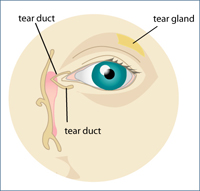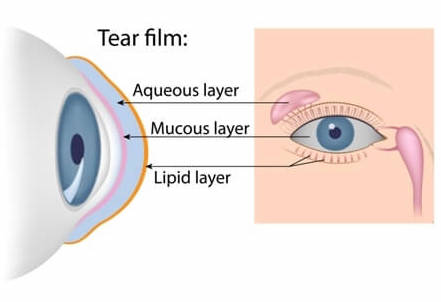Causes and Risk Factors
What are the causes of dry eye?
 Dry eye can be a temporary or chronic condition:
Dry eye can be a temporary or chronic condition:
- Dry eye can be a side effect of some medications, including antihistamines, nasal decongestants, tranquilizers, certain blood pressure medicines, Parkinson’s medications, birth control pills and anti-depressants.
- Skin disease on or around the eyelids can result in dry eye.
- Diseases of the glands in the eyelids, such as meibomian gland dysfunction, can cause dry eye.
- Dry eye can occur in women who are pregnant.
- Women who are on hormone replacement therapy may experience dry eye symptoms. Women taking only estrogen are 70 percent more likely to experience dry eye, whereas those taking estrogen and progesterone have a 30 percent increased risk of developing dry eye.
- Dry eye can also develop after the refractive surgery known as LASIK. These symptoms generally last three to six months, but may last longer in some cases.
- Dry eye can result from chemical and thermal burns that scar the membrane lining the eyelids and covering the eye.
- Allergies can be associated with dry eye.
- Infrequent blinking, associated with staring at computer or video screens, may also lead to dry eye symptoms.
- Both excessive and insufficient dosages of vitamins can contribute to dry eye.
- Homeopathic remedies may have an adverse impact on a dry eye condition.
- Loss of sensation in the cornea from long-term contact lens wear can lead to dry eye.
- Dry eye can be associated with immune system disorders such as Sjögren’s syndrome, lupus, and rheumatoid arthritis. Sjögren’s leads to inflammation and dryness of the mouth, eyes, and other mucous membranes. It can also affect other organs, including the kidneys, lungs and blood vessels.
- Dry eye can be a symptom of chronic inflammation of the conjunctiva, the membrane lining the eyelid and covering the front part of the eye, or the lacrimal gland. Chronic conjunctivitis can be caused by certain eye diseases, infection, exposure to irritants such as chemical fumes and tobacco smoke, or drafts from air conditioning or heating.
If the surface area of the eye is increased, as in thyroid disease when the eye protrudes forward or after cosmetic surgery if the eyelids are opened too widely, dry eye can result. - Dry eye may occur from exposure keratitis, in which the eyelids do not close completely during sleep.

Who is likely to develop dry eye?
Elderly people frequently experience dryness of the eyes, but dry eye can occur at any age. Nearly five million Americans 50 years of age and older are estimated to have dry eye. Of these, more than three million are women and more than one and a half million are men. Tens of millions more have less severe symptoms. Dry eye is more common after menopause. Women who experience menopause prematurely are more likely to have eye surface damage from dry eye.


